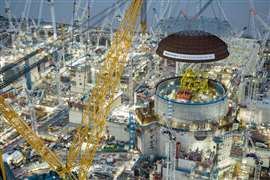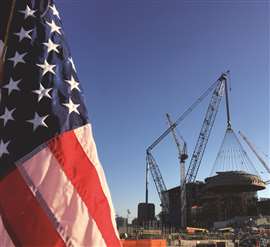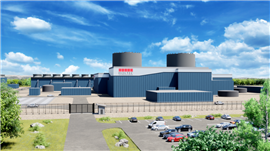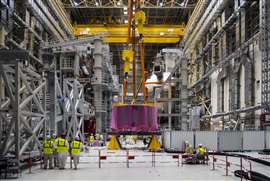Are western nuclear construction ambitions out of step with reality?
25 January 2024
 The world’s biggest crane, Big Carl, has lifted the 245-tonne domed roof onto the first reactor building at Hinkley Point C. (Image: EDF)
The world’s biggest crane, Big Carl, has lifted the 245-tonne domed roof onto the first reactor building at Hinkley Point C. (Image: EDF)
The UK’s Hinkley Point C nuclear power plant could well end up being the most expensive ever built.
Construction on the plant, being developed by French energy firm EDF, started in March 2017 but the first unit may now not be operational until the end of the decade, according to an update earlier this week from Hinkley Point C managing director Stuart Crooks.
Delays, which Crooks blamed on a combination of the Covid-19 pandemic, Brexit, and design changes to meet UK regulations, have also caused the budget to swell to £31 billion - £35 billion at 2015 prices, up from a 2022 estimate of £26 billion. That means that the plant could cost as much as £46 billion (US$58.7 billion) at today’s prices.
The news comes at a difficult time for the UK government, which only weeks before pledged the biggest expansion in nuclear power plant construction in 70 years with the dual aim of meeting its net zero carbon emissions goals and bolstering the country’s energy security.
It launched consultations on the future siting of nuclear power stations and another on supporting the sector and encouraging private investment. And just days later, a development consent order was issued for a new 3.2GW plant, also being developed by EDF, at Sizewell C.
Crooks is confident that despite the delays at Hinkley Point C, construction work at its successor Sizewell C will run more smoothly.
“[The experience at Hinkley Point C] means we have a complete design approved for use in Britain and the chance to repeat it with teams and suppliers that have the know-how and are already at work. The benefits of repeating an identical design gives Sizewell C a massive advantage,” he said.
West struggles to build on time and on budget
But others question whether the UK’s grand ambitions to build both largescale nuclear plants and develop small modular reactors (SMRs) are realistic. And there’s concern that the problems here are indicative of a wider challenge when it comes to nuclear construction projects in the western world.
“One important thing we need to understand is that there is a difference between aspirations and what is realistic in the nuclear construction space,” Chris Gadomski, nuclear analyst with Bloomberg New Energy Finance, told Construction Briefing.
“I thought the announcement led by the UK and the US at COP 28 that we are going to triple nuclear capacity by 2050 was perhaps a little bit premature. The problem is going to be in the execution. If the announcement had been made by China and Russia then it would hold a little bit more water.
“I think the western world has lost the ability to build large nuclear power plants on time and on budget, which is a sad thing to say,” he added.
 The Lampson International LTL-2600 made 1,000-ton lifts at the Plant Vogtle jobsite in Burke County, GA.
The Lampson International LTL-2600 made 1,000-ton lifts at the Plant Vogtle jobsite in Burke County, GA.
Gadomski said that Bloomberg NEF’s estimates suggested that it costs around a quarter to build a nuclear power plant in China using their technology as it does in the UK and the US.
While Hinkley Point C in the UK is the latest major plant to grab the headlines, there have been similar challenges involved in the construction of reactors 3 and 4 at the Alvin W. Vogtle plant in Georgia in the southeastern US. Construction on two additional Westinghouse AP1000 reactors started there in 2009 but work was heavily delayed, exacerbated by the bankruptcy of Westinghouse in 2017. Unit 3 only completed in July 2023, while work on Vogtle 4 is still ongoing, with costs climbing from an estimate of $25 billion in 2018 to $34 billion last year.
“I divide the world into two halves: the western and eastern hemispheres,” said Gadomski. “In the east, the demand for nuclear is fuelled by the demand for electricity. The Chinese are demonstrating that they can build large reactors relatively inexpensively. Russia is demonstrating that they can build them in places like Egypt and Turkey.
“We’re not sure how much they will cost but they have the wherewithal, the state support and the supply chain to go ahead and build those reactors. It’s my hypothesis that there will be no large reactors built in the western hemisphere because we don’t know how to do them economically.”
The exception to that could be Sizewell C, assuming that EDF makes a final investment decision on the project. On 22 January, the UK government announced £1.3 billion (US$1.7 billion) in additional investment to fund infrastructure like roads and rail lines to keep the project on track ahead of EDF’s final investment decision.
“You might as well build the other two [EPR reactors] at Sizewell C after the huge investment in Hinkley so you can amortise the labour force, the experience, and the maintenance,” Gadomski said.
The attractiveness of building SMRs…and their challenges
The cost involved in building largescale nuclear power plants has boosted the attractiveness of SMRs.
Less expensive to build, they represent a “big opportunity”, says Gadomski. There’s also demand for them in regions like eastern Europe that is trying to move away rapidly from coal-fired power stations.
 Digital rendering of Holtec’s Dual-Unit SMR-300 small modular nuclear plant in perspective view (Image: Holtec)
Digital rendering of Holtec’s Dual-Unit SMR-300 small modular nuclear plant in perspective view (Image: Holtec)
Partnering with companies like GE Hitachi to repurpose existing coal plants in eastern Europe, removing the coal burners and putting SMRs in their place “makes a tremendous amount of sense”, according to Gadomski, although there are social, environmental and political concerns to deal with.
“Then you go into places like Africa and Southeast Asia where there’s a tremendous amount of demand for electricity. We hope to point them away from building fossil fuel plants and so there is a market opportunity there but it is perhaps going to follow on the heels on the success of SMRs in western established markets,” Gadomski says.
But here too there are challenges, as the recent failure of the NuScale Carbon Free Power Project in Idaho, USA due to a lack of investor appetite showed.
“Inflation and higher interest rates are going to be a brake on the development of these SMRs,” said Gadomski. “I am always watching very carefully how much money is being raised by investors to show the level of global interest. Otherwise you are going to have a government-led industry, which has proven successful in Russia and China.”
“But it’s not so much the design of the reactor that is important but the expertise of the construction engineering firms to build these products on time and on budget. To a large extent, that has been lost.
“I would suggest that the driver behind the decision to build plants like Hinkley Point C was employing 25,000 people. You have this dangerous metric where nuclear power plants become a convenient way of employing a lot of people for long periods of time. And so the nuclear power industry becomes a source of employment as opposed to a source of the least expensive delivery of electricity. In this strange, upside-down world we live in in the West, that can be very advantageous and drive political decisions.”
Slow decision-making
Those decisions can be slow, however.
The UK government is in the process of running a competition to find companies to build SMRs under government contracts. In October 2023, it whittled it down to six designs from EDF, GE Hitachi Nuclear Energy International, Holtec Britain, NuScale Power, Rolls Royce SMR, and Westinghouse Electric Company UK.
The aim is to announce in spring this year which of the six companies the government will support, before making a final investment decision in 2029 with a view to the plants being operational by the mid 2030s.
 (Photo: ITER)
(Photo: ITER)
With an investment decision still five years away, Gadomski questions whether SMRs represent enough of a leap forward in technology. “All of the reactors that are either boiling water or light water reactors and represent an incremental move forward in nuclear innovation, where we have just shrunk the size of conventional reactors.
“Theoretically, we are doing that so we can manufacture them in a factory and make them cheaper. But Bill Gates would argue that the future of nuclear is a fast reactor technology. That is much more complex, a greater technological risk, and it isn’t close to being ready. But it helps to address the problem of spent fuel, which is a looming issue for the nuclear industry and some Canadian utilities are choosing it based on not only generating electricity but also how it can help to address the spent fuel problem,” Gadomski says.
And then, further on the horizon, is the prospect of nuclear fusion plants, which further muddies the waters when it comes to which technology to invest in and develop.
“There is a lot of hype and anticipation around fusion. But it could be a game changer and we are watching the progress of these fusion companies very closely,” Gadomski added.
“The nuclear industry has been looking at the challenges that renewables and cheap natural gas has presented to it. They should start looking over their shoulder to see how real the challenge is from fusion. If there is a net energy gain from a small fusion reactor, which is going on at ITER and First Light Fusion in Oxford in the UK, then that changes a lot of calculations for the whole industry and it confuses the decision-making process.
“If you are a utility planner, are you going to commit to an SMR reactor with the fact that this fusion activity is going on? What that tends to do is delay decisions – and fusion may never happen. It’s a fascinating and challenging market to follow.”
STAY CONNECTED



Receive the information you need when you need it through our world-leading magazines, newsletters and daily briefings.
CONNECT WITH THE TEAM








